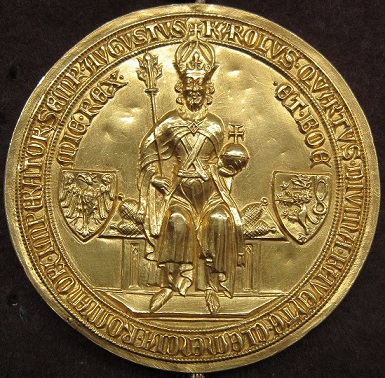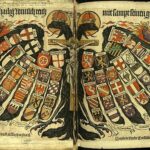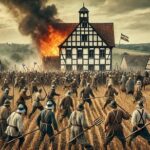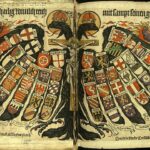
In the heart of the 14th century, amid feudal rivalries and imperial disputes, a single document aimed to bring order to the chaos. Issued by Emperor Charles IV, the Golden Bull of 1356 didn’t just organize a political process—it laid the groundwork for the structure of the Holy Roman Empire that would endure until the 19th century.
Often called Germany’s medieval constitution, the Golden Bull defined how emperors would be chosen and who held real power in the empire. But beyond the legal jargon, it tells us a lot about how Germany functioned—and fractured—in the Middle Ages.
Let’s unpack this golden decree and explore how it shaped the politics, power, and identity of medieval Germany.
The Context: A Fragmented Empire
By the mid-14th century, the Holy Roman Empire was more of a confederation of territories than a centralized state:
- Local princes, bishops, and dukes held most real power.
- Emperors were elected, not hereditary.
- Frequent disputes over succession weakened imperial authority.
The empire needed a clearer system to avoid chaos and conflict. Enter Charles IV—a savvy Bohemian ruler with a grand vision.
Charles IV and the Diet of Nuremberg
Charles IV wanted stability and legitimacy. In 1356, he convened an imperial diet (assembly) in Nuremberg and later Metz, where he introduced a document that would codify the rules of the empire.
The result? The Golden Bull, named for the golden seal (bulla aurea) attached to official copies.
Key Provisions of the Golden Bull
The Golden Bull contained 31 chapters, but here are the most important highlights:
1. Fixed Number of Electors
The document confirmed that seven prince-electors had the exclusive right to elect the Holy Roman Emperor:
- Three ecclesiastical: Archbishops of Mainz, Trier, and Cologne
- Four secular: King of Bohemia, Count Palatine of the Rhine, Duke of Saxony, Margrave of Brandenburg
This formalized an oligarchic electoral college that would choose emperors for the next 400+ years.
2. Majority Rule
A simple majority among electors was enough to elect an emperor. No more unanimous votes. This sped up elections and limited deadlock.
3. Imperial Coronation
Once elected, the emperor had to be crowned in Aachen, the city of Charlemagne.
4. Hereditary Rule for Electors
Each electoral position became hereditary within noble families. This reinforced dynastic power and gave stability to the electoral process.
5. Autonomy for Electors
Electors were granted near-sovereign power in their own lands:
- The right to mint coins
- Maintain armies
- Administer justice
- No appeals to imperial courts from their subjects
This entrenched regional independence, a defining feature of medieval and early modern Germany.
6. Suppression of City Leagues
The Golden Bull also sought to weaken urban coalitions, like the Swabian League, that threatened noble authority. It banned cities from forming alliances without princely permission.
Symbolism and Ceremony
The Golden Bull wasn’t just a legal document—it was a display of imperial prestige. It emphasized:
- The divine right of emperors
- The sacred nature of the coronation
- The ceremonial hierarchy of the empire
This helped project unity and legitimacy, even as real power remained fragmented.
Long-Term Impact
The Golden Bull became a foundational document of the Holy Roman Empire. Its legacy includes:
- Creating a formal electoral system that lasted until 1806
- Reinforcing regional autonomy, especially for powerful states like Saxony and Bohemia
- Limiting the emperor’s ability to centralize power
It also delayed the emergence of a unified German state, keeping Germany a patchwork of principalities while France and England moved toward central monarchy.
Criticism and Legacy
Some historians argue that the Golden Bull cemented disunity, making Germany vulnerable to future conflict. Others see it as a pragmatic compromise, recognizing realities on the ground and preventing civil wars.
In modern Germany, the Golden Bull is remembered as:
- A cornerstone of constitutional history
- A reflection of medieval political thought
- A reminder of the empire’s complexity
Where to See It Today
Original copies of the Golden Bull survive in archives in Vienna, Frankfurt, and Prague. Visitors can also explore sites associated with its creation:
- Nuremberg, where the first chapters were issued
- Metz, where later sessions were held
And of course, Aachen Cathedral, where emperors were crowned, remains a living symbol of imperial tradition.
The Golden Bull of 1356 wasn’t flashy—but it was foundational. It gave structure to an empire held together by tradition, diplomacy, and negotiated power. It told electors who they were. It told emperors how they could rule. And it defined Germany’s medieval political culture for centuries.
Related Articles:
The Middle Ages in German History – An overview of the political, cultural, and religious transformations that shaped Germany from the fall of the Carolingian Empire to the dawn of the Reformation, including the rise of the Holy Roman Empire and medieval society.
Otto I and the Birth of the Holy Roman Empire – Explore how Otto I’s coronation in 962 marked the formal beginning of the Holy Roman Empire, establishing a powerful political and religious legacy in medieval Germany.
Medieval German Feudal Society – Learn how landholding, loyalty, and class defined the social structure of medieval Germany, shaping both everyday life and royal authority.
The Hanseatic League – Discover the rise of this powerful trade alliance of northern German cities that dominated commerce across the Baltic and North Seas during the late Middle Ages.
German Castles and Knightly Culture – Dive into the architectural and chivalric world of medieval Germany, where fortified castles and knightly ideals shaped warfare, literature, and noble identity.
The Black Death in Germany – Trace the devastating impact of the 14th-century plague on German towns and villages, altering demographics, labor systems, and religious life.
Peasant Revolts in the Middle Ages – Examine the causes and consequences of peasant uprisings in medieval Germany, including their role in challenging feudal oppression and economic hardship.
The Teutonic Knights and Eastern Expansion – Follow the military and missionary campaigns of the Teutonic Order as they expanded Germanic influence eastward into pagan territories.







